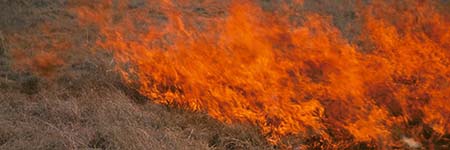
Wild fire in the grassland
Photo: Supplied |
The influence of fire on the ecosystem in the higher rainfall ‘‘sour’’ grassland areas of southern Africa has been well established. However, less information is available for arid and semi-arid ‘‘sweet’’ grassland areas, says Prof Hennie Snyman, Professor in the Department of Animal, Wildlife, and Grassland Sciences, about his research on the short-term impact of fire on the productivity of grasslands in semi-arid areas.
Sour and sweet grassland areas can be defined as receiving either higher or lower than approximately 600 mm of rainfall respectively. In quantifying the short-term impact of fire on the productivity of grasslands in semi-arid areas, a South African case study (experimental plot data) was investigated.
“Burned grassland can take at least two full growing seasons to recover in terms of above- and below-ground plant production and of water-use efficiency (WUE). The initial advantage in quality (crude protein) accompanying fire does not neutralise the reduction in half of the above-ground production and poor WUE occurring in the first season following the fire.
“The below-ground growth is more sensitive to burning than above-ground growth. Seasonal above-ground production loss to fire, which is a function of the amount and distribution of rainfall, can vary between 238 and 444 kg ha -1 for semi-arid grasslands. The importance of correct timing in the utilisation of burned semi-arid grassland, with respect to sustained high production, cannot be overemphasised,” said Prof Snyman.
In arid and semi-arid grassland areas, fire as a management tool is questionable if there is no specific purpose for it, as it can increase ecological and financial risk management in the short term.
Prof Snyman said: “More research is needed to quantify the impact of runaway fires on both productivity and soil properties, in terms of different seasonal climatic variations. The information to date may already serve as valuable guidelines regarding grassland productivity losses in semi-arid areas. These results can also provide a guideline in claims arising from unforeseen fires, in which thousands of rands can be involved, and which are often based on unscientific evidence.”
For more information or enquiries contact news@ufs.ac.za